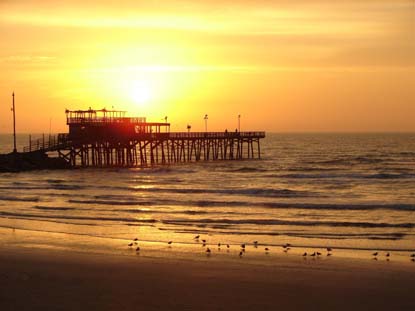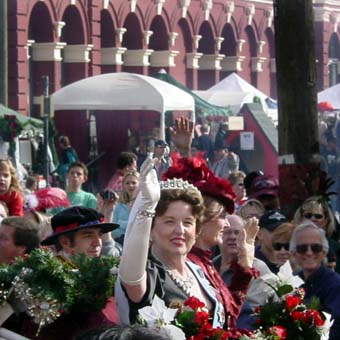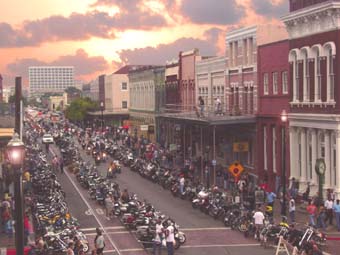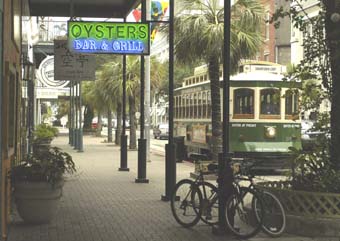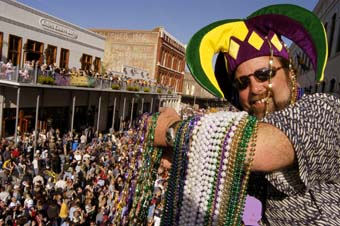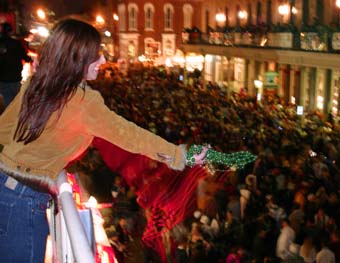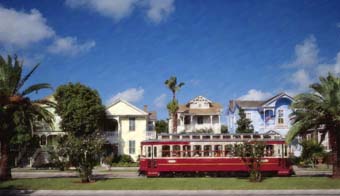A mother laughs in mock dismay as her toddler
ruins their perfect sand castle by sloshing a bucket of water on
it. Some teenage boys decide to do some body boarding despite the
lack of waves on this broiling day. A couple sits drinking their
Miller Light longnecks while listening to the country music crooning
through the radio.
Galveston never ceases to amaze me. Despite
the baking temperatures, brown water, threat of hurricanes, and
the oil refineries, nothing stops us from coming here. This is our
beach.
I have seen Miami and countless other beaches
in Florida. I have been to California. I have seen beaches in New
Jersey, and the beaches of other Gulf towns such as Biloxi, Mississippi.
All are beautiful in their own way. Their clear water, powdery sand,
and lovely beach houses and condominiums are often pictured on the
covers of travel magazines. The beaches in some of these areas set
the standard for what a “beautiful” beach town should
be. But they still aren't Galveston.
My friends, family, and I have often laughed
and joked about how our beach towns along the Texas Gulf Coast compare
to others in the United States. I have to admit, we have poked fun
at our Galveston. Yet, if I hear “an outsider” say anything
about our little getaway island, I feel as if someone has insulted
a family member that I am particularly fond of. This is a Texas
double standard; I can make fun of my relations, but no
one else can. In Texas, you just do not mess with family. And although
this family member may not be the most beautiful, she has spirit,
character, and a personality all her own.
There are many things that people do not
know about our Galveston. Most people know it for the obvious: the
seven mile-long seawall that protects the island from the constantly
encroaching Gulf waters. This wall has done its job through many
hurricanes, with the exception of “The Great Hurricane of
1900,”which completely obliterated Galveston as the booming
metropolis it was at the turn of the century. Few people know that
this hurricane still holds the title of the most deadly natural
disaster in the U.S.; an estimated 6000 to 12,000 people were killed.
Feeling protective of Galveston, I have returned for a closer look.
A friend and native to Galveston agrees
to help me get another up close and personal look at very familiar
territory. As we drive through the town, she points out lovely Victorian
mansions I had rather taken for granted. Each of these grande dames
has a history of her own, a story to tell. The mansions vary in
shape and color, and some have definitely seen better days. You
can almost feel the presence of their former selves, sad victims
of the storm of the century; apparitions looming in the shadows
of Galveston's past.
My friend knows them well; she engages me
with tales of death, sadness, love, and loss. I am enthralled by
their drama and rich history. Many natives swear that ghosts are
still present in them to this day. Being somewhat of a mystical
bent, I am inclined to agree. As spooky as it may sound, none of
this takes away from the charm of Galveston. And during the island's
Mardi Gras, the houses really come into their own.
The history of Galveston begins long before
the boom and bust times from which it never quite recovered. The
first people who inhabited this little island were the Karankawa
and Akokisa
Indian tribes. Galveston was also the starting point for Cabeza
de Vaca’s famous trek to Mexico. This European
explorer who set the stage for the conquest of Native America, was
eventually shipwrecked there in 1528. Galveston was named in honor
of Bernardo de Galvez by the explorer Jose de Evia who charted the
Gulf Coast of the United States.
Some time later, a pirate named Louis Michel
Aury, who had previously occupied Galveston, returned from an unsuccessful
raid on Spanish territory only to find that the area had been taken
over by none other than the infamous pirate Jean
Lafitte. Lafitte took up residence in Galveston after
being driven out of New Orleans. There are, I might add, many similarities
between the two cities. It is almost as if Galveston is a miniature
version of New Orleans — the New Orleans we all knew and loved
before Hurricane Katrina.
With its own very special version of Mardi
Gras (parade included) and its own jazz festival, Galveston is a
taste of New Orleans in our own backyard. During Mardi especially,
you can imagine drunken pirates wandering the town with their booty
their arms slung around the shoulders of a local wench. The music,
the crowds, the beads, the all-night drinking and celebration must
have started back then.
However, the pirate times in Galveston did
not last, and Lafitte was eventually given an ultimatum by the United
States navy. Shape up or ship out. Incorrigible, he left Galveston
under the cover of night, but not before he burned the settlement
to the ground.
A spirit of independence and self-determination
has always been part of the culture of Galveston. When Mexico won
its independence from Spain in the early 1820s, the newly formed
national government designated Galveston as a major port of entry
to the new nation. Later, during the Texas
Revolution, the little town served as a major port
for the navy of Texas. In 1836, Michel B. Ménard, a French-Canadian
purchased several thousand acres of land and formed what would become
modern Galveston. And then in 1939, the city became fully represented
in the Congress of the Republic of Texas.
And the free spirit of Galveston is also
embodied in “Junteenth”
(also known as Freedom Day or Emancipation Day). The commemoration
of the end of slavery in the United States every June 19th, also
has roots in Galveston. On June 19th, 1865, General George Granger
marched his troops into the business district of Galveston (known
as the Strand) and read aloud Abraham Lincoln's proclamation which
ended slavery.
On closer examination, I can now see that
Galveston is its own sub-culture of Texas, made up of a myriad of
idiosyncratic personalities, buildings, restaurants, and shops —
especially on the Strand.
I have special fond memories of going to
La King’s old-fashioned confectionary — It's still there!
— as a little kid and tugging at my mom’s shirt, begging
her to buy me some of the store's homemade sweets. After a long
sun-drenched day at the beach, it would be a cool and inviting escape
for my rumbling belly and my lobster-colored face. I would watch
transfixed as the homemade saltwater taffy swirled around the rotating
machine in a thick silky ribbon. And my appetite would grow as I
ran back and forth from “the ice cream side” to “the
candy side,” desperately trying to decide what to get because
I was only allowed one treat. After once I made what to me was a
life-altering decision, my family and I would sit down at the little
Victorian-style marble tables and enjoy our post-swimming delicacies.
And when I visit Galveston, I am still the proverbial kid in a candy
store.
While I'm on
the topic of food, let me tell you that there are so many different
kinds of restaurants in and around Galveston, that you can eat your
way around the island. I remember huge dinners at the famous, and
for me very classy, “Gaido’s Famous Seafood Restaurant”
overlooking the seawall. I would sit at the table and watch the
waves, and then when the waiter brought the warm bowl of lemon water
and a towel to wipe my hands with, I would demonstrate my social
graces — a real little lady. It was for me the height of sophistication.
Gaido’s is still there, and although as an adult I still enjoy
the fine dining, the kid in me still feels rather grand.
My reminiscing
about Galveston would not be complete without my mentioning Dickens
on the Strand. Every year at Christmas, the Galveston
Strand is converted into a Victorian holiday celebration complete
with food, shopping, costumes, and music to fit the Victorian theme.
In fact, those who show up in “period attire” get into
the celebration free.
I remember especially my middle school hand-bell
group. Our choir teacher made us homemade Victorian school outfits,
and paraded up and down the Strand performing while onlookers smiled
and waved. We thought we were the élite of all hand-bell
players, especially when we played the “Carol of the Bells”
while shivering crowds in the grandstands listened. Even on a hot
summer's day on the beaches of Galveston, I can still hear the sweet
tinkling of our bells, taste the hot chocolate, and feel the surprisingly
biting cold of the December air in Galveston. The soft glow of the
lights on a real old-fashioned Christmas tree, the sounds of our
parents cheering, and the goose bumps made for a perfect Christmas
Carol. We were so proud. And it never occurred to me that all the
Christmas rituals and the Dickens theme were just a touch incongruous
with this little island off the coast of south Texas. On Galveston,
anything is possible.
As my thoughts turn back from the Christmas
air to the blistering heat and burning sand under my feet, I am
overwhelmed by the sensory memories evoked by this little island
we call Galveston.
I have a hunch that the pirates knew that
they had found a hidden treasure in our Galveston.
More about Galveston....
* Galveston has a little something for everyone.
It's a great family destination for this reason. Many people are
now buying vacationhomes in Galveston; it's more affordable beach
living. Seventy-five per cent of Galveston visitors come from
within a 300 mile radius, with a majority from Houston. However,
this is a destination not only for Texans, but for everyone.
* The Grand Opera House is a great place
to see shows, and has been in operation since from 1894. It has
also survived all of Galveston's hurricanes (even the big one in
1900). It is listed in the National Register of Historic places.
It presents over 25 shows annually: touring Broadway shows, and
musical talents of all kinds. Stars like Robert Earl Keen and Tony
Bennett are featured.
* Be sure to see the Texas Seaport Museum
and Tall Ship Elissa. This beautiful ship is a floating
national historic landmark and dates back to 1877. You can tour
the ship and see the museum and film next door, which documents
the rescue of the ship. You will also learn a lot about the maritime
history of Galveston.
* Schlitterbahn is a huge water park that
just opened in summer of 2006.
* Don't miss The Great Storm at
the Pier 21 theater. This is a short but educational and touching
film about the great storm of 1900.
* Galveston has a laid back, yet energetic
nightlife. Here you will find everything from Irish pubs, upscale
bars, and many live music venues. Nightlife can also be geared to
people of different ages and tastes.
* One of the places that was damaged in the
last major storm was Yagas, a very popular live music venue. Please
note that they are in the process of rebuilding and restoring it.
* Galveston has many festivals in addition
to jazz fest and mardi gras (which were mentioned in the article).
They have an Octoberfest, Greek Festival (October 13th-15th), BBQ
and Wild Game Cook Off (proceeds go to charity), and Artwalk. As
for the latter, once a month all of the art galleries open their
doors to the public. People wander through the galleries while sipping
cocktails. Galveston has more than a dozen art galleries. Oh, and
you should note that the AIA (American Institute of Architects)
sand castle competition is a
huge event for Galveston. There is also a historic homes tour in
the spring that is highly recommended. Chcek out the Lone Star Motorcycle
Rally which is usually held in the month of October.
* The Railroad Museum is a must — the
history of railroading in Texas;Galveston was a huge part of this.
It has three diesel engines and three steam engines on site that
can be toured as well as audio devices that help tell the story.
* Galveston Island State Park has a theater
with outdoor musicals from June to late August nightly except Sundays.
* Other restaurants to visit: Di Bella's
(Italian), Rudy and Paco's, The Taco House, and the Mosquito cafe
are some of my favorites.
* There are many choices in accommodation
from inexpensive to high-end. The famous San Luis Resort (all rooms
have a view of the ocean) is in the latter category.
* And of course, there is jet skiing, parasailing,
and other yahoo activities available near the beaches.
